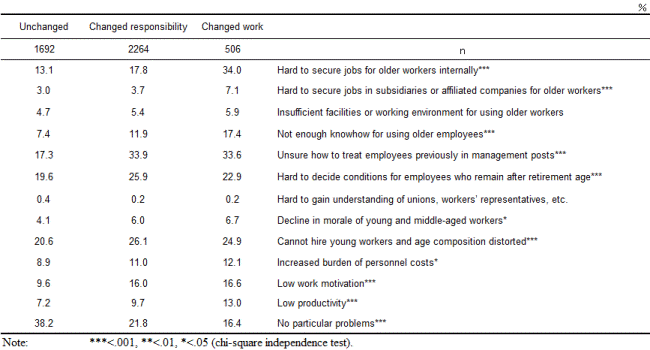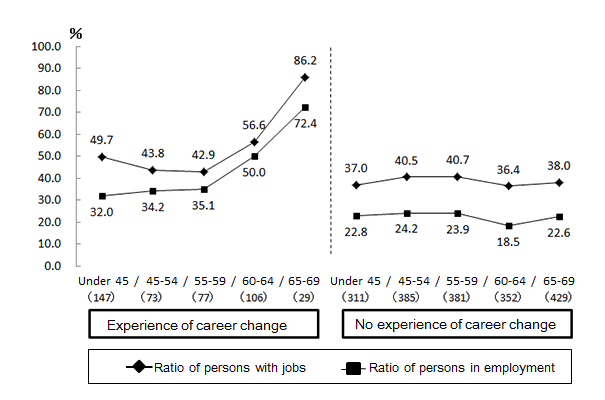JILPT Research Report No.186
Elderly Employment in an Era of Labor Shortage
November 30, 2016
Summary
Research Objective
Amid an increasingly serious labor shortage due partly to population decline, it is now of utmost importance that we build a social environment in which older people can play more active role. Specifically, as continued employment in companies becomes an established norm for people in their early 60s, it is important that we increase productivity by further development of their abilities and efficient employment management, among other efforts. For those in their late 60s and above, the challenge is expected to be one of increasing their activity, on the assumption that population decline and labor shortages will progress further in future.
The purpose of this research is to explore directions for solutions to these issues, using the results of questionnaire surveys and others previously conducted by JILPT.
Research Method
Members of a “Research Group on Elderly Employment” consisting of both JILPT and external researchers prepared a draft based mainly on questionnaire surveys concerning elderly employment conducted by JILPT. The manuscript was then studied by the Research Group and compiled in the form of this report.
Main Findings and Policy Implications
In Chapter 1, “Present situation and issues of elderly employment,” the situation surrounding elderly employment is described and problems in the employment of older persons are discussed. The latter are divided into three types, namely “Problems in the employment of older persons in their early 60s,” “Problems in the employment of persons in their late 60s and over, or older persons in general,” and “Problems in active participation by older persons and related measures.” Specifically, in “Problems in the employment of older persons in their early 60s,” the challenge is to study systems of employment management that will be accepted by employees, enabling them to work and be highly productive, given the change to mandatory employment until age 65. Meanwhile, the most important challenge seen in “Problems in the employment of persons in their late 60s and older, or older persons in general” is to expand employment by promoting continued employment, particularly by those aged 65 and over, in a society with a progressively shrinking population. Finally, in “Problems in active participation by older persons and related measures,” there are various conceivable issues, including (i) active participation by older persons in diverse working styles, (ii) employment of older persons and pension systems, and (iii) various activities, health and care burdens of older persons.
Chapter 2, “Corporate roles and human resource management of persons in continued employment in their early 60s,” identifies three patterns in which employees are allocated in continued employment after mandatory retirement. Namely, (i) the “unchanged type,” in which the job content remains unchanged after retirement, (ii) the “changed responsibility type,” in which the job content is unchanged but the level of responsibility is changed (such as by removal from management positions), and (iii) the “changed work type,” in which the job content is changed after mandatory retirement. The characteristics of human resource management for each type are then explored.
The “unchanged type” differed greatly from the other two types in terms of securing employment for those in their early 60s. Specifically, many companies were aware of “No particular problems” when securing employment for those in their early 60s, but more companies in the “changed responsibility type” and “changed work type” were aware of problems. In the “changed duties type,” the treatment of employees who were in management positions was seen as the major issue; in the “changed work type,” the main problem lay in securing jobs that older persons could handle inside their companies, in addition to the treatment of employees who were in management positions (Table 1).
One future direction that could be extrapolated from this would be to increase the number of companies practicing the unchanged type of employment management, in which the job content remains unchanged after mandatory retirement. This is because problems in securing employment for those in their early 60s are more likely to be reduced when using this unchanged type, compared to the other two types (the changed duties and changed work types). Another direction for the future is the need to consider providing support that will help to resolve problems typically confronting companies that practice the other two types (changed responsibility, changed work) – namely, the problems of securing jobs for older persons and the treatment of employees previously in management positions.
Table 1. Problems in securing employment for the early 60s (multiple responses)

In Chapter 3 “Employment and career changes of workers in their late 60s and above,” the following facts were revealed.
(i) For men, older age is a period of more significant change than middle age when it comes to employment; many of those who remain employed past 65 have experienced some kind of career change along the way (Figure 1). In the process, many change from regular employment to diverse forms of employment (particularly part-time work), transfer from large corporations to smaller companies such as small and medium enterprises, or shift to service jobs or others that differ from their previous ones.
(ii) While career changes are sometimes based on temporary transfer to another company while maintaining employment relationship with the original company (shukko), permanent transfer to another company (usually an affiliate or a subsidiary), or mediation by the original employer (tenseki), independent job-seeking activity is also important for those seeking employment past the age of 65. “Hello Work” (public employment security offices) have a dominant role to play in this process, but at the same time, various channels for matching jobs with workers are being used for career changes in older age, depending on the employment format and the types of job and role sought.
This Chapter also stresses the importance of developing schemes to encourage employment among workers who are thought to have not saved enough to support themselves in old age (“older persons in urgent need of work”). This suggests a new perspective when considering ways of encouraging older persons to stay in employment - namely, that measures based on the actual situation of their livelihood are also important.
Figure 1. Current employment situation by experience of career changes in different age groups (males, aged 65-69)

Chapter 4, “Study of determining factors in companies where employees can continue working past 65” analyzes whether continued employment after the age of 65 is possible, leading to the suggestion that, in companies where regular employees in their 50s more frequently quit their jobs, it is more likely that all employees aged 65 or over can keep working if they wish to do so. This result could suggest a need, when considering elderly employment, not only to look at the situation of continued employment among the over-60s, but also to ascertain the overall image of elderly employment, including the situation up to age 60. It also suggests that, in companies on a large scale in terms of employee numbers, with a high ratio of regular employees and a large rate of wage decrease as employees reach 60, continued employment past 65 tends to be impossible for all employees; and that, in order to utilize older persons even past the age of 65 in these companies, their employment management system including the wage curve would need to be fundamentally reviewed.
Chapter 5, “What sort of companies hire older persons in mid-career?”, analyzes mid-career hiring of older persons, and concludes that, if a company prefers wage determination to be based on a system of evaluation even for older persons after retirement age, the likelihood of mid-career hiring for regular employees will be higher. In future, sectors with manpower shortages are expected to increase and the market for mid-career hiring of older persons is expected to become more active. This produces the highly suggestive assertion that setting wages based on a system of evaluation is important as a prerequisite for this.
Chapter 6, “Determinant factor analysis of the motivation to continue NPO activity among middle-aged and older persons,” verifies four hypotheses (the human capital utilization hypothesis, the consumption model hypothesis, the activity incentive hypothesis, and the compensation factor hypothesis) regarding determinants of the motivation to continue NPO (nonprofit organization) activity among those in middle-aged to older age brackets (50-59, 60-64, 65 and over). As policy implications, this Chapter suggests ways of encouraging these people to continue NPO activity (support for NPO activity by persons with medical qualifications, implementing a reliable remuneration system, publicity targeting at middle-aged and older persons, and support for those in low unearned income brackets). This could conceivably be useful as reference when older persons choose NPO activity as an activity in various forms.
Chapter 7, “Employment, health, and care burdens of older persons,” analyzes how subjective sense of health and burdens of care impact the employment of older persons in their 60s, while also analyzing the impact of employment on subjective sense of health. As policy implications, it is suggested that (i) a broad range of living support (including health promotion) aimed at middle-aged and older persons could encourage them to stay in employment, (ii) reducing burdens on caregivers could help to promote employment among older persons, and (iii) policies that encourage older persons to stay in employment are effective in promoting their health. In particular, not only will continued employment be promoted if older persons stay in good health, but the fact that promoting continued employment by older persons will itself help to promote their health is also a useful analysis result for creating collaborations between elderly employment policies and health policies.
Policy Contribution
Measures for elderly employment.
Contents (available only in Japanese)
- JILPT Research Report No.186 Whole text (PDF:5.3MB)
If it takes too long to download the whole text, please download each file separately.
- Cover – Preface – Authors – Contents (PDF:534KB)
- Chapter 1 Present situation and problems of elderly employment
Part I Problems in the employment of older persons in their early 60s (PDF:1.7MB) - Part II Problems in the employment of persons in their late 60s and over, or older persons in general (PDF:1.7MB)
- Part III Problems in activity by older persons and related measures (PDF:1.1MB)
Research Category
Project Research: “Research on Employment / Labor in Response to Changes in Economic and Social Environments in Japan”
Subtheme: “Changes in the labor supply-demand structure and employment-labor project” Research on employment of older persons
Research Period
FY2012-FY2016
Researchers
- Takaaki TAHARA
- Research Director, The Japan Institute for Labour Policy and Training
- Makoto FUJIMOTO
- Senior Researcher, The Japan Institute for Labour Policy and Training
- Yutaka ASAO
- Project Researcher, The Japan Institute for Labour Policy and Training
- Tetzushi KAMAKURA
- Assistant Fellow, The Japan Institute for Labour Policy and Training
- Haruhiko HORI
- Senior Researcher, The Japan Institute for Labour Policy and Training
- Xinxin MA
- Associate Professor, Institute of Economic Research, Hitotsubashi University
- Kunio MIMURA
- Lecturer, Institute of Economic Research, Hitotsubashi University
Catergory
Related Research Results
- Research Series No.156 Survey research on the employment of middle-aged and older people (2016)
- Research Series No.149 Survey research on the job change or re-employment of middle-aged and older people (2016)
- Research Series No.147 Survey on questionnaires concerning cash stipend for job seekers with (2016)
- Research Series No.135 Survey research on the Life and Employment of persons in their 60s (2015)
JILPT Research Report at a Glance
| To view PDF files, you will need Adobe Acrobat Reader Software installed on your computer.The Adobe Acrobat Reader can be downloaded from this banner. |

